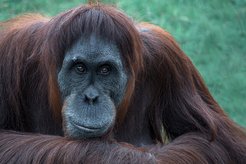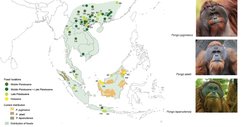Retracing 45,000 Years of 'Emptying Forests'
How records of past human-primate interactions can inform conservation efforts
Ecologists and wildlife biologists have sounded the alarm: we now stand at a ‘tipping point’ of global species extinctions, with human actions primarily responsible for taking us to the brink of a sixth mass extinction. Non-human primates are among the most vulnerable animals, with the International Union for Conservation of Nature (IUCN) noting that almost half of the world’s 512 recognized primate species face extinction. The biodiversity hotspots of tropical and subtropical Asia, host to 187 different primate taxa, are set to be most affected. The IUCN estimates that the populations of 91% of Asian primate species are decreasing. Several factors have been identified as causing primate population declines, including habitat loss due to industry, agriculture, logging and climate change. Likewise, illegal wildlife trade, bushmeat consumption, and the use of body parts for traditional medicines are also threats to primate populations in the region.

To come up with effective conservation policy, it is therefore essential to distinguish between the impacts of environmental change and direct anthropogenic pressures on different primates. In a review paper just published online by Trends in Ecology and Evolution, researchers from the Max Planck Institute for the Science of Human History highlight the role that zooarchaeology could play in guiding primate conservation efforts in Asia.
The team compiled archaeological evidence for the use of primates in South and Southeast Asia during the last 45,000 years and found that primates have played important roles as targeted prey since humans arrived in the region. In addition to their use as food, primates have long been a source of materials for technological development and symbolic material culture, such as the use of monkey bones and teeth in producing tools and ornaments and the inclusion of monkeys as ‘burial goods.’ The data shows that past human societies targeted some species that are now critically endangered, such as orangutans and gibbons, as well as species which ethnographic research had previously documented, like langurs. As human development led to major changes in land cover, new primates appear as prey, including some macaque species.
After analyzing the compiled zooarchaeological data, the team concluded that environmental factors appear to have played a greater role than human activity in past primate distribution and abundance, foreshadowing the environmental and land-use change precipitated by human activity that are the major threats of the 21st century.

Analysis also revealed that the different primate species had varying trajectories through time, taking orangutans and long-tailed macaques as examples. The fossil record shows a much wider past distribution of the orangutan, with several species occurring across Southern China and mainland Southeast Asia prior to 20,000 years ago. By around 12,000 years ago, orangutans were restricted just to the islands of Borneo and Sumatra, an 80% reduction of their original range. This is in contrast to long-tailed macaques, which have been introduced outside their original range to the Philippine islands and as far as New Guinea and Mauritius.
However, the researchers acknowledge that the zooarchaeological record has its limitations, considering both the nature of the evidence and the current data gaps. Nonetheless, they argue that the illustration of human hunting of different taxa, alongside assessment of palaeoenvironmental records, can be used to explore how different primate species fared in the face of both anthropogenic and climatic pressures in the past and be used to inform conservation priorities and policies.

